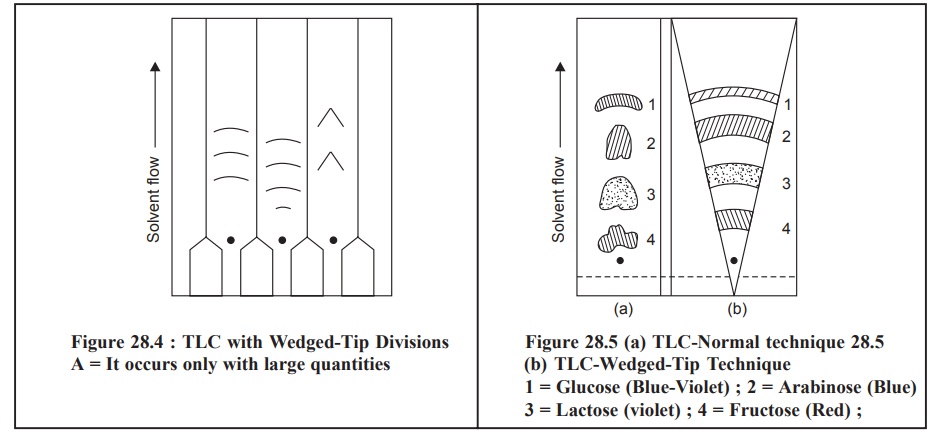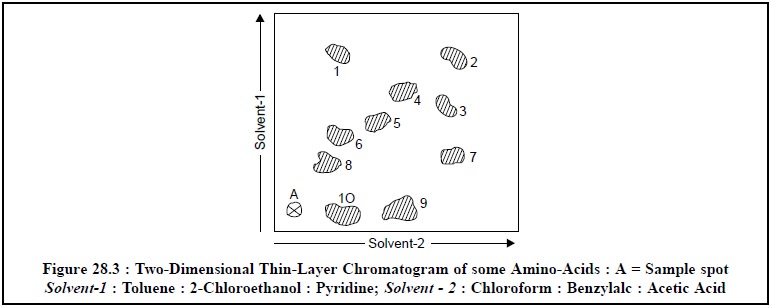Chapter: Pharmaceutical Drug Analysis: Thin Layer Chromatography (TLC)
Special Techniques in Thin Layer Chromatography (TLC)

SPECIAL TECHNIQUES IN TLC
The various special techniques applicable in TLC are
enumerated below briefly with specific examples wherever possible, namely :
(i) Horizontal TLC :
Mistryukov in 1961
introduced this technique whereby the horizontal development of loose-layer TLC
plates were made by using a shallow dish having a ground glass cover. The TLC
plate was carefully rested on a T-shaped glass piece and the starting end was
pressed duly against a filter paper held by another glass strip, which allowed
the solvent to move to the thin-layer-film from the bottom of the dish by
capillary action.
Example : Methyl esters of mixed fatty
acid may be separated on loose-layer of alumina using suit-able solvent-system.
(ii) Continuous TLC :
It is good for the separation
of such components having small as well as very close Rf values and may be achieved by using :
(a) Rectangular
horizontal plates where the solvent is allowed to move over them and
subsequently evaporated after it has almost reached the end of the run, and
(b) Triangular
glass-plates-where the mixture to be separated is spotted near the apex on a
thin-layer and two different solvent mixtures are fed from two sides to the
thin-layer and fractions subsequently collected at the base (Reisert,* 1963 ;
Turins** ; 1965 ;).
(iii) Preparative TLC :
TLC may be skillfully extended
to cater for extremely useful method for pre-parative separations. To maintain
uniformity, as a rule, plates of 20 cm height and 20-100 cm length with layers
between 0.5 and 0.2 mm thickness are normally employed. It essentially has
three cardi-nal features, namely :
(a) Component
mixtures is always obtained either in streaks or bands,
(b) Separation
is invariably accomplished by multiple development, and
(c)
Localization of separated components is only done under UV-light.
Note : Amount of constituents
ranging between 0.1 and 100 g can be separated without any loss easily.
(iv) Multiple Dimensional TLC :
It can be regarded as a variant of multiple development
chromatog-raphy. It could be expatiated with the help of the following typical
example, namely :
Example : Separation of mixture of fatty
acids, cholesterols and their esters ; lecithins and polar lipids*** :

(v)Two-Dimensional Chromatography :
It is also termed as two-dimensional planar chromatography. Here, the sample is spotted in one corner of a square TLC plate (size : 20 cm × 20 cm) as shown in Figure 28.3. The development is first carried out in the ascending direction using solvent-1 (see legend of Figure 28.3). The solvent is then eliminated by evaporation and the plate is rotated through 90°, following which ascending with the second solvent is accomplished. After removal of the solvent the spots of separated constituents are located by spraying with specific reagents.

Example : Mixture of amino acids
obtained from protein hydrolysates are separated by this method* and
spots located by using Ninhydrin Reagent that forms a pink to purple product
with amino acids.
(vi) Centrifugal Chromatography :
It essentially makes use of the ‘centrifugal force’ so as
to acceler-ate the flow of solvent through the thin-layer of the chromatogram.
Korzum and Brody** in 1964, first applied this method to TLC, whereby the
layers of plaster-of-paris bound alumina or silica gel were directly applied to
either circular glass or aluminium plates with a hole in the centre to enable
it to fit into the centrifuge. As usual, the sample mixture is applied 2.5 cm
from the centre hole and the solvent system is set to allow a constant flow,
with the centrifuge rotating at 500-700 RPM. In this manner, the usual
developing time of 35 minutes is drastically reduced to mere 10 minutes by
acceleration.
(vii) Wedged-Tip Chromatography :
Reindel et al*** (1953) and Mathias**** (1954)
introduced the wedged-tip technique
in TLC which essentially exhibit the following two plus points, namely :
(a) Improved
separation, and
(b)
Constituents forced to assume an almost band-like path.
Figure 28.4, depicts the TLC-plate with wedged-tip
divisions. The following steps are to be adopted sequentially, namely :
(i) Draw
dividing lines 0.5 to 1.0 mm broad on the surface of the layer with a
narrow-metal spatula,
(ii) Pentagons
are facilitated by the help of a stencil made of transparent plastic material,
and
(iii) Sample
mixture are applied to the narrow portion of the wedge to get the best results.
Figure 28.5, illustrates TLC of an urine sample by the
normal TLC-technique vis-a-vis the
wedged-tip technique (Figure 28.5(b)).
One may clearly visualize the beautiful separated bands in the latter as
compared to the several odd and irregular-shaped spots in the former. Both the
clarity of separation and the reproducibil-ity of the results are predominant
in the latter technique. Figure 28.5 (a)
and (b) represent the typical
analysis of a urine sample containing glucose, arabinose, lactose and fructose
respectively.

Related Topics